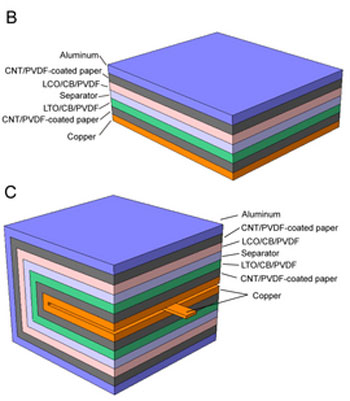| Oct 23, 2013 |
Art form, nanotechnology combine to advance batteries
|
|
(Nanowerk News) A combination of nanotechnology and the traditional art of paper folding, known as origami, could be a key to a significant step toward improved battery technologies.
|
|
Arizona State University engineers have constructed a lithium-ion battery using paper coated with carbon nanotubes that provide electrical conductivity.
|
|
Using an origami-folding pattern similar to how maps are folded, they folded the paper into a stack of 25 layers, producing a compact, flexible battery that provides significant energy density – or the amount of energy stored in a given system or space per unit of volume of mass.
|
 |
| The above image illustrates the architecture of a foldable lithium-ion battery ASU engineers have constructed using paper coated with carbon nanotubes. They began with a porous, lint-free paper towel, coated it with polyvinylidene difluoride to improve adhesion of carbon nanotubes and then immersed the paper into a solution of carbon nanotubes. Powders of lithium titanate oxide and lithium cobalt oxide – standard lithium battery electrodes – are sandwiched between two sheets of the paper. Thin foils of copper and aluminum are placed above and below the sheets of paper to complete the battery.
|
|
Their research paper in the journal Nano Letters
("Folding Paper-Based Lithium-Ion Batteries for Higher Areal Energy Densities") has drawn attention from websites that focus on news of technological breakthroughs.
|
|
The researchers have also developed a new process to incorporate a polymer binder onto the carbon nanotube-coated paper. The polymer binder improves adhesion of the structure’s active materials.
|
|
The achievements open up possibilities of using the origami technique to create new forms of paper-based energy storage devices, including batteries, light-emitting diodes, circuits and transistors, says Candace Chan, who led the research team.
|
|
Chan is an assistant professor of materials science and engineering in the School for Engineering of Matter, Energy and Transport, one of ASU’s Ira A. Fulton Schools of Engineering.
|
|
Fellow ASU engineering faculty members, associate professor Hanqing Jiang and assistant professor Hongyu Yu, have played leading roles in the work.
|
|
We have also covered this work in our Nanowerk Spotlight series here: Nanotechnology researchers fabricate foldable Li-ion batteries.
|

